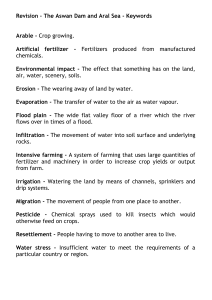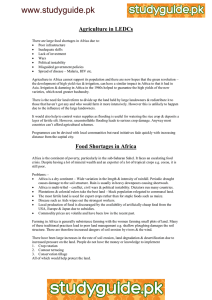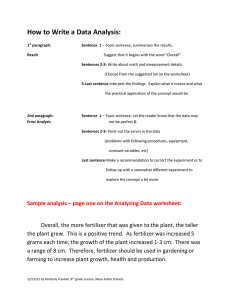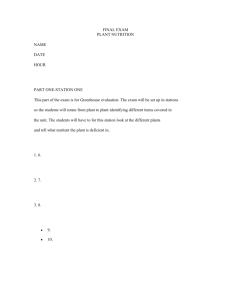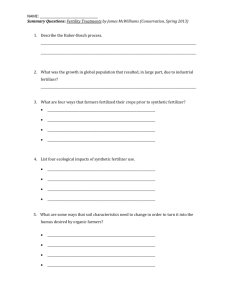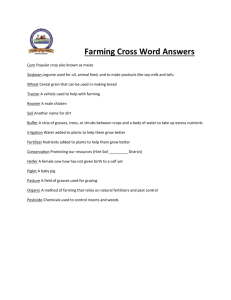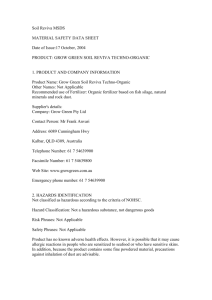Appendix: Spotlight 3 The Yen Chau—Hiep Hoa Case Study: Avoiding P
advertisement
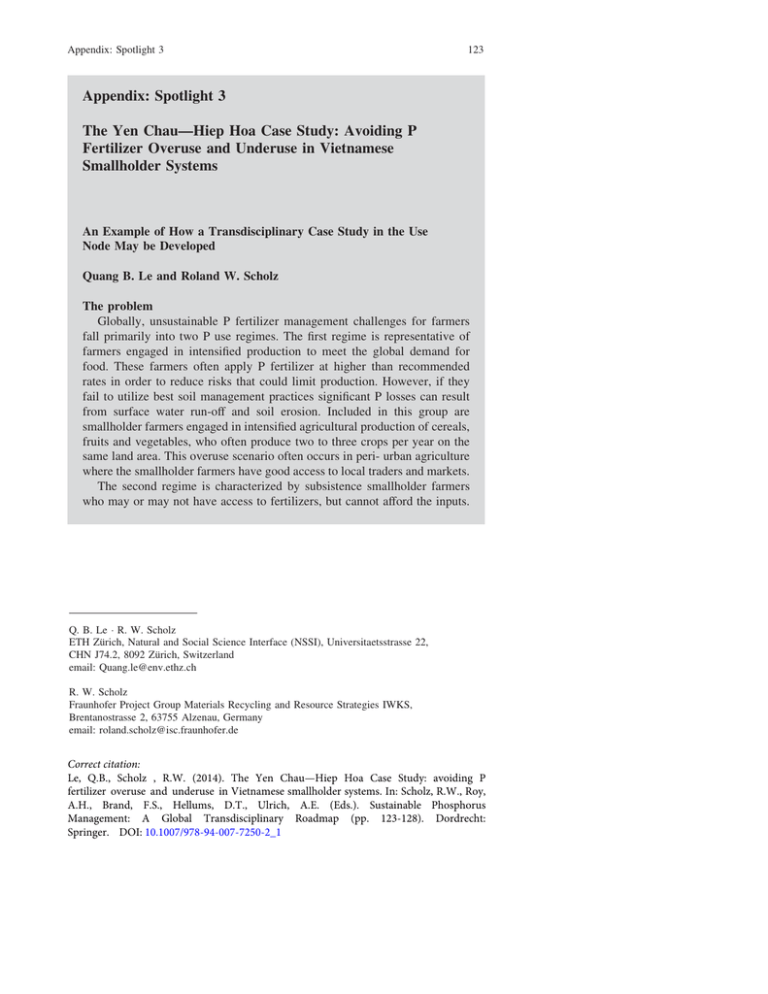
Appendix: Spotlight 3 123 Appendix: Spotlight 3 The Yen Chau—Hiep Hoa Case Study: Avoiding P Fertilizer Overuse and Underuse in Vietnamese Smallholder Systems An Example of How a Transdisciplinary Case Study in the Use Node May be Developed Quang B. Le and Roland W. Scholz The problem Globally, unsustainable P fertilizer management challenges for farmers fall primarily into two P use regimes. The first regime is representative of farmers engaged in intensified production to meet the global demand for food. These farmers often apply P fertilizer at higher than recommended rates in order to reduce risks that could limit production. However, if they fail to utilize best soil management practices significant P losses can result from surface water run-off and soil erosion. Included in this group are smallholder farmers engaged in intensified agricultural production of cereals, fruits and vegetables, who often produce two to three crops per year on the same land area. This overuse scenario often occurs in peri- urban agriculture where the smallholder farmers have good access to local traders and markets. The second regime is characterized by subsistence smallholder farmers who may or may not have access to fertilizers, but cannot afford the inputs. Q. B. Le R. W. Scholz ETH Zürich, Natural and Social Science Interface (NSSI), Universitaetsstrasse 22, CHN J74.2, 8092 Zürich, Switzerland email: Quang.le@env.ethz.ch R. W. Scholz Fraunhofer Project Group Materials Recycling and Resource Strategies IWKS, Brentanostrasse 2, 63755 Alzenau, Germany email: roland.scholz@isc.fraunhofer.de Correct citation: Le, Q.B., Scholz , R.W. (2014). The Yen Chau—Hiep Hoa Case Study: avoiding P fertilizer overuse and underuse in Vietnamese smallholder systems. In: Scholz, R.W., Roy, A.H., Brand, F.S., Hellums, D.T., Ulrich, A.E. (Eds.). Sustainable Phosphorus Management: A Global Transdisciplinary Roadmap (pp. 123-128). Dordrecht: Springer. DOI: 10.1007/978-94-007-7250-2_1 124 Q. B. Le and R. W. Scholz Here P fertilizer is underused, leading to nutrient mining and soil degradation which exacerbates poverty. In both cases, viable options for economically and environmentally efficient P resource use and recycling in smallholder agro-ecosystems require special attention. Vietnam’s smallholder systems in the Red River Delta (fertilizer-overuse, market-oriented) and in the Northwest Mountain Region (fertilizer-underuse, subsistence) will be used as example cases for contrasting two P use regimes. 1. Building partnership and Td organization Science-practice co-leaders from the Province’s People Committees in Son La and Bac Giang provinces, and researchers from science (ETH, University of Zürich etc.) are interested in understanding mechanisms of sustaining traditional industries in rural regions. Jointly, they will decide to run a Td case study and to take co-leadership on equal footing for a tdprocess. The co-leaders preside over the steering group. Project groups—Reference groups: The scientific work will take place in project groups spanning the case facets (see session Case Faceting below). The project groups are counterbalanced on the case side with the ‘‘so-called’’ reference groups, which are the committees of stakeholders relevant for the respective case facet (Stauffacher et al. 2008). The reference group regularly meets their corresponding project group to discuss the results and subsequent steps of the work. Steering group: The group consists of representatives of the scientific disciplines involved in the study topic (e. g., soil and crop scientists, environmental chemists, human-environment system scientists), as well as the representatives of the two provinces. During the problem definition process, representatives of a few (2–3) selected districts/communes will join the steering group. As the study progresses, the steering group will identify additional participants who should be involved in each phase of the project based on the nature of the work (Stauffacher et al. 2008). For this, it seems meaningful/necessary that both locations, i. e., Yen Chau and Hiep Hoa about 12–16 farmers make commitment to be involved in the study and the mutual learning process. These farmers will be key members of the reference groups. 2. Joint problem definition The steering group members (which include the main stakeholder groups) will negotiate and define guiding question, goal and the case areas (system boundaries). Guiding questions: As a result of science-practice discussion, examples of possible guiding questions could be: Project year 2013: What are science-based and society-relevant strategies for P resource use that help improve soil fertility, food productivity and profitability for Vietnamese smallholders of two contrasting P use regimes? What options/ Appendix: Spotlight 3 125 pathways/means are available for the transition of current smallholders’ P use to a sustainable use of P? Goal: Based on these questions, the goal of the case study can be defined so as to provide (strategic) orientations for future development of smallholders regarding P use. Case definition: The case study should allow to better understand ‘‘overuse’’ and ‘‘underuse’’ of P under certain constraints. The case’s characteristics and contextual factors should allow some generalization for other cases (we are investigating cases for something of general interest). Based on reviewing the existing classification of world farming systems (Dixon et al. 2001), the global pattern of agronomic P balance (MacDonald et al. 2011), and national patterns of climate, soil, demography and land uses, the steering group—presumably interacting with regional case stakeholders—identifies case areas in the Hiep Hoa and Yen Chau districts. Characteristics of these areas are in Table 8. Based on extensive farm survey across the selected areas, a limited number of farms (about 6–8 farms/site) representing major farm types will be selected for further considerations. Case faceting: The goal of faceting is the formulation of a research concept, which is written by the scientists in collaboration with practitioners. Together with the stakeholders, the involved scientists create a general model of smallholder farming system in the two districts with a focus on P use, which allow the application of relevant disciplinary fields and their theories. In order to reduce the complexity and to better analyze the farming practices a ‘faceting’ of the case should be done. Facets (which have to be discussed) could be: ‘Crop-Livestock Production including P fertilizer use and flows’, ‘Household Decision’, and ‘Policy, Finance and Market’. Consequently, three corresponding project groups should be formed. For each case facet, P-use related scientific tasks (subprojects) will be identified. In the presented case, there may be an additional project group which focuses on integrating/synthesizing the results from the subprojects, i. e. the so-called ‘‘Integrated Assessment’’ group. It is expected that the case faceting will jointly identify a couple (common) disciplinary sub-tasks with particularly disciplinary foci, such as: Crop-livestock production, P fertilizer use and flows • Current state of P use and cycle in the study of smallholder systems, • problems in P fertilizer use, P-cycle management with respect to sustaining soil fertility and crop/livestock production, • potential alternatives for P use technology/practice and (on-farm) recycling • household decisions, • social-policy, economic, ecological factors that affect farmers’ decision about nutrient use and management, Lowland rice-based farming system in Eastern Asian tropical monsoon climate About 71 million ha, mainly located in flood-plains of South and Central East China, Korean peninsula and Southeast Asia 28.5 thousand ha 216 thousand people (95 % of total population) (2008) Plinthic Acrisols River floodplain Crop: Paddy rice (80 % of total crop area), maize, beans, vegetables. Livestock: pig (high density), poultry, cattle. Aquaculture: fish ponds Market-oriented. Both crop and livestock productions are important sources of cash income. Vegetable is increasingly grown to meet the increasing market demand Existing fertilizer use and Intensive uses of inorganic fertilizers, combined with some nutrient management manures. Nutrient loop between crop-livestock-fish in some households. About 80 % of animal manure is discharged to the environment Prevalence of food Medium insecurity and poverty Key problems (1) lost yield if no or less use of fertilizer, (2) low fertilizer use efficiency, (3) high livelihood vulnerability to increase in fertilizer cost, (4) water pollution Cultivation area Agricultural population Main soil (FAOUNESCO) and land form Key components of smallholder farming system General livelihood strategy World regional farming system/climate zone (Dixon et al. 2001) Table 8 Regional settings of the two study areas Aspect Hiep Hoa district (P fertilizer overuse) (1) degraded soil and declining crop yield, (2) very low household income, (3) knowledge, cultural and labor constraints for nutrient recycling practices, (4) lack of access to fertilizer and food market, financial services Crop: Maize (70–60 %), paddy and upland rice, cassava, beans, vegetable, fruit trees. Livestock: pig, cattle (open raising, extensive care). Aquaculture: fish ponds Subsistence. Maize, rice and cassava are important food crop. No/weak market links for some marketable crop (maize and fruits) Compound NPK, urea and K fertilizers are used only for a very small share of cropland. Almost no P fertilizer for hillside crops. Manure is seldom used. Nutrient recycling or soil conservation practice is hardly observed Very high (poverty hotspot in Vietnam) 201 thousand ha 65 thousand people (95 % of total population) (2009) Ferrasols, Acrisols Complex mountain Highland extensive mixed farming system in Eastern Asian tropical monsoon climate About 8 million ha, mainly located in mountains of Southeast Asia Yen Chau district (P fertilizer underuse) 126 Q. B. Le and R. W. Scholz Appendix: Spotlight 3 127 • interferences between farmer’s decision-making and other important human agents at higher levels (e. g., provincial department of agriculture and rural development, rural credit agencies, traders). Policy, finance and market • Constraints in policy (e. g., subsidy), finance institution (e. g., rural loans/ credit institution) and market (e. g., prices of farming inputs and outputs) with respect to smallholder’s P uses, • potential alternatives for improving these factors. Integrated Assessment • Integrated Assessment including conceptual and parameterized system model that integrates the above-mentioned facets, • scenarios of soil fertility, food productivity & profitability versus P use strategies, evaluation of trade-offs. 3. Joint problem representation System analysis: A special challenge of the td-process is to collaborate with the decision makers and the stakeholders in a way that the system model and what is focused can be understood by all key (practice) case agents. The system model should represent the smallholder agro-ecosystem in a way that all can understand the dynamics of soil fertility and food production in response to changes in P use and other related drivers (e. g., fertilizer subsidies, market prices). The system model will serve as a basis for the construction of case scenarios in the next steps. Moreover, the joint system model construction will result in a shared representation of the constructed case study. This shared constructive aspect should greatly enhance the mutual learning process. Scenario construction: For each case area, through Td workshops, stakeholders will jointly identify a set of different alternative P use strategies that they would like to evaluate. By means of either the computerized system model or a scientific participatory method so-called ‘‘formative scenarios analysis’’ (Scholz and Tietje 2002), future scenarios of identified outcome variables corresponding to the alternative strategies will be constructed. The scenarios will also be presented in a verbal or visual form that can be understood by the stakeholders and all case agents involved. 4. Assessment and preparing for sustainable transitions The above-mentioned strategies will be evaluated by referring to scientific data to gain insights into trade-offs, e. g., between costs and benefits or 128 Q. B. Le and R. W. Scholz environmental impacts and economical cost driven by the alternative strategies. Further and complementary to that, participatory multi-criteria assessment (Scholz and Tietje 2002) will be used. Different stakeholder groups will evaluate the different scenarios. This will serve to identify tradeoffs between the stakeholder groups and between different aspects of p-use that may be improved. For each meaningful scenario, tradeoffs (between social, economic and environmental impacts; between different preference systems of stakeholder groups) will be identified. Based on this, a process of mutual understanding will be moderated and consensus can potentially be formed on many issues. 5. Outcomes and follow-ups In the final Td workshops, stakeholders will discuss how the knowledge generated in the process should be used for different societal processes, such as farming practices, policy decisions, sustainability learning in higher education systems, framing of follow-up research activities. As one important follow-up, written products will be prepared both for practice partners (e. g. practice manuals, policy briefs) and scientists (articles in academic journals). References Dixon J, Gulliver A, Gibbon D (2001) Farming systems and poverty—improving farmers’ livelihoods in a changing world. FAO, Rome and Washington D.C. MacDonald GK, Bennett EM, Potter PA, Ramankutty N (2011) Agronomic phosphorus imbalances across the world’s croplands. PNAS 108(7):3086–3091 Scholz RW, Tietje O (2002) Embedded case study methods: Integrating quantitative and qualitative knowledge. Sage Publications, Thousand Oaks Stauffacher M, Flüeler T, Krütli P, Scholz RW (2008) Analytic and dynamic approach to collaborative landscape planning: a transdisciplinary case study in a Swiss pre-alpine region. Syst Prac Action Res 21(6):409–422
